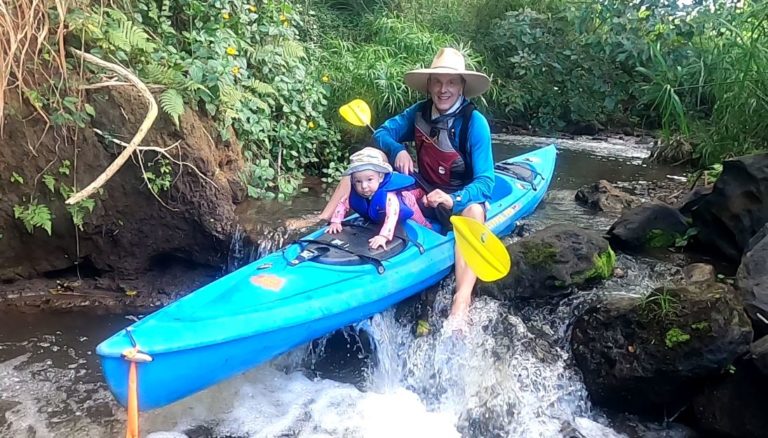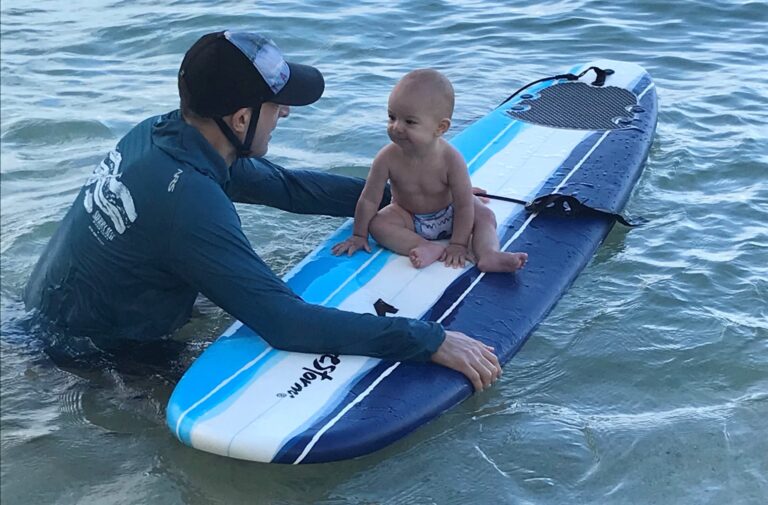Deciding what to wear on your white water rafting trip depends primarily upon the type of river trip and the time of year. However, almost no matter where you raft it is best to bring river attire for sun and cold. Even during the summer, a splashy day of rafting can turn cold when the sun goes behind some clouds.
In this post we try to help you understand how to best use the items on your packing list and steer you towards some of our preferred gear options. We’ve broken down our list into essential items and later discuss additional options that can improve your rafting experience.
River Rafting Essentials
There are essentials you will want to bring on any whitewater rafting trip. Key apparel includes protection for your feet, some sort of swim suit to wear on its own or under a wetsuit, and clothing for protection from the sun. Having the wrong gear can be a safety concern. Rafting clothes need to protect you from the elements (sun, hot or cold) while not impeding swimming incase you find yourself in the river. Many outfitters provide wetsuits and splash jackets for colder trips.
List of Essential Clothes and Gear to Bring Rafting
- PFD (Personal Flotation Device)/Lifejacket
- helmet (PFDs and Helmets are provided by outfitters on commercial trips)
- shoes or sport sandals
- bathing suit
- sunscreen (see our post on best sunscreens for water sports)
- sun hat
- sun glasses with strap
- long sleeve non-cotton shirt or sun hoodie
- water bottle
- waterproof jacket or splash jacket (colder trips, sometimes provided by outfitters)
- thicker fleece top (colder trips)
- wetsuit (colder trips, sometimes provided by outfitters)
- change of clothes
PFDs
For rafting the ideal PFD has at least 22 lbs of flotation and can be adjusted to sit low on your torso. Lifejackets should be type III or V and in good shape with no tears or faded material. Commercial outfitters provide PFDs and helmets on their trips, many times they will not let you us your own PFD if you bring it. Read our in-depth post on PFDs.
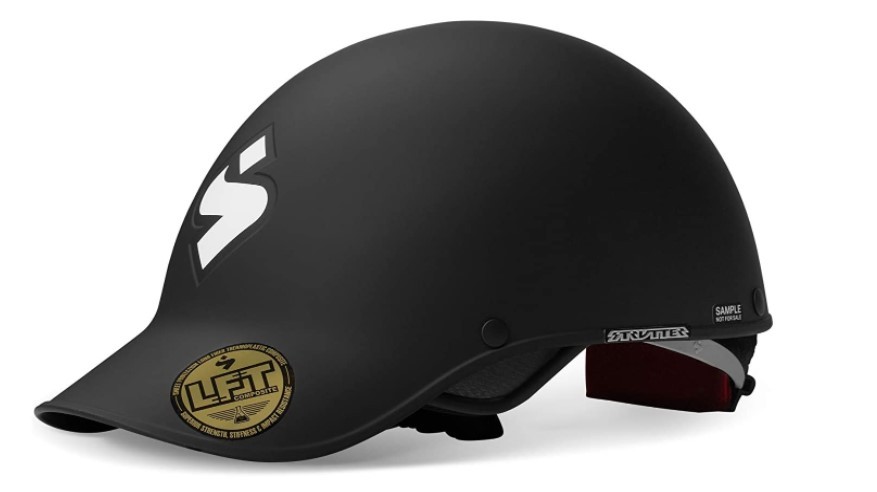
Helmets
A helmet needs to fit snuggly enough so that it doesn’t shift around. Look for a helmet that provides coverage of the temples and ears. Helmets with fixed bills (see photo above) can cause injury if the wearer is thrown forward into the neck of another person, avoid these types of helmets. With a new helmet be sure to test it out in a controlled swim before using it. I’ve seen multiple people take a bad swim in a new helmet because it fell in front of their face.
Rafting River Shoes
Choosing the right river shoes requires considering numerous factors, so we’ve written an entire post on selecting rafting footwear. The synopsis is wear rafting shoes that protect your toes, dry quickly, secure well and have soft rubber soles. Save flip-flops and crocs for when you are off the water. Currently the most popular river footwear is old running sneakers followed by the Astral Brewer river shoe and Chaco river sandal.

Bathing suits
Boardshorts work well for men and women. Ladies prefer a two-piece swim suit or board shorts and a sports bra to make going to the bathroom during the day easier. I’m a fan of long boardshorts that cover my knees. During spring trips it is nice to have a swimsuit that doesn’t bunch up under a wetsuit making it easy to put on your wetsuit. In this case lighter weight and shorter bottoms work best.
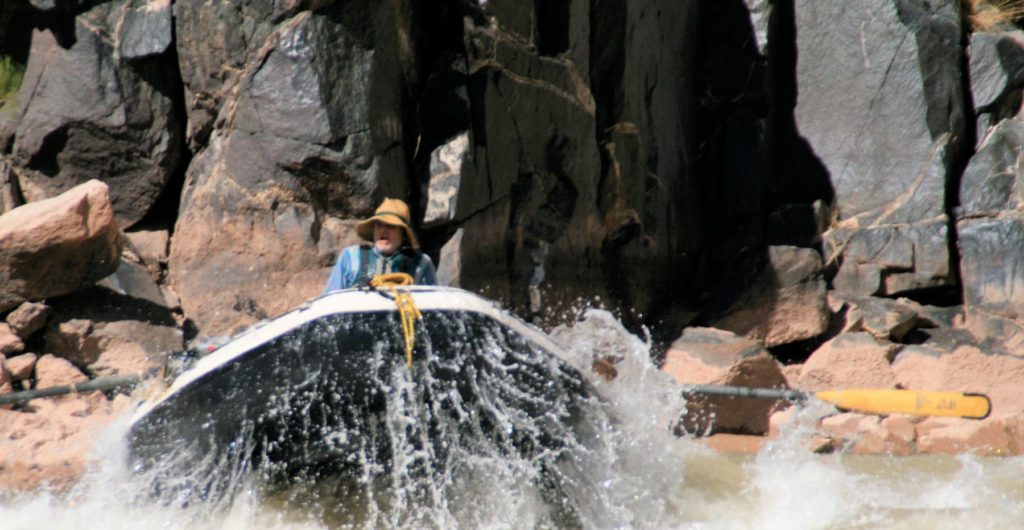
Sun Protective Clothing + Sunscreen
When rafting on hot sunny days in June, July and August the common places to burn include the head/face, feet, knees, arms and hands. While sunscreen helps with prevent sun burns, covering up works better. When rafting you are getting wet all day so sunscreen needs to be reapplied regularly which is difficult when you are wet. Here is what we wear on hot summer days of rafting.
Sunscreen for Rafting
Unless you cover your entire face you’ll need to use some sunscreen. The best sunscreens for the aquatic environment are ones that use non-nano zinc oxide. All other types seem to cause problems for coral and other aquatic animals. Avoid bringing spray-on sunscreen on the river, everyone else on the trip does not enjoy breathing sunscreen into their lunges. Spray-on sunscreens also contain agents that have been shown to cause cancer in rats when inhaled.
Sun Hats
Wide brimmed hats are ideal for rafting trips without helmets. Yes they are dorky but dorky usually means works well! Be sure the hat has a good chin strap to keep it on in rapids and if you swim. A hat with a solid strap also helps keep sunglasses on your head.
If you are wearing a helmet on your rafting trip, a baseball cap works well under the helmet. However, sometimes the hat bill can fall in front of your face when swimming. Test out your set-up to be sure you can swim with it. Also, use baseball caps without the little button on top if possible. They work best with helmets.
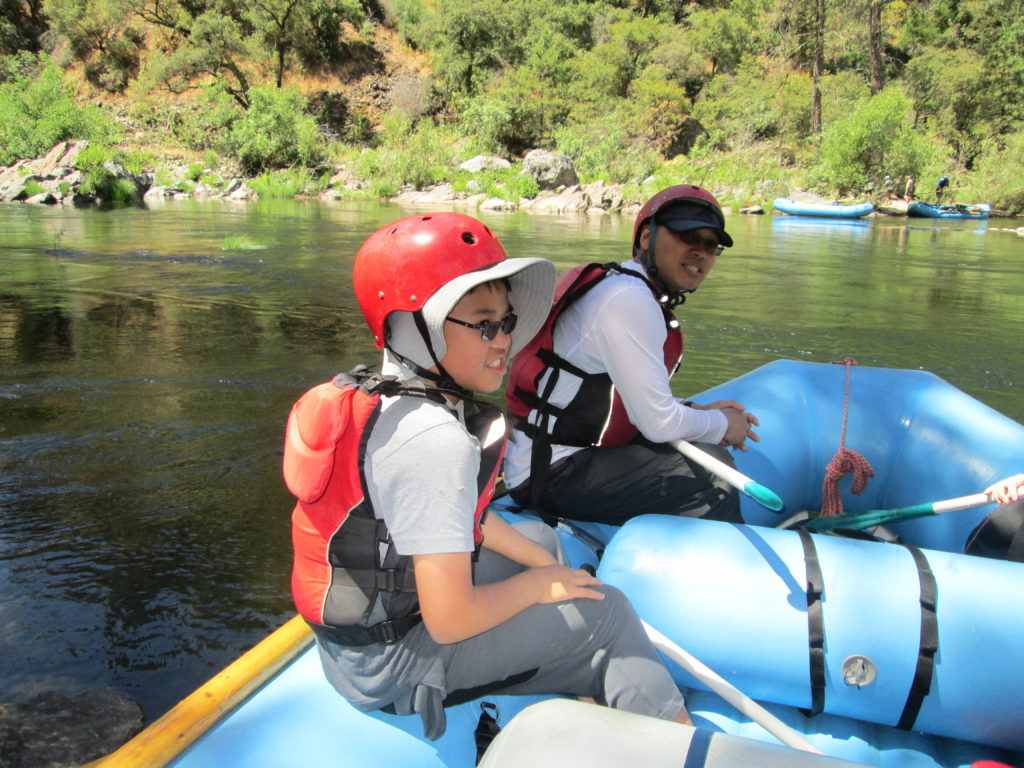
Sun Glasses with Retention Strap
Polarized sunglasses dramatically reduce glare off the water compared with regular sunglasses. Be sure to use a quality retention strap like croakies or chums. While chums seem to stay on sunglasses better, they stay wet much longer and end up rotting. Sunglass arms pull out of older croakies but they are lower profile and seem to last longer in the water environment. By far the best way to secure your sunglasses is to use a pair of chums and then wear a hat with a chin strap on top of the chums.
UPF Buffs/Neck Gaiters
Neck Gaiters protect your neck and face well when the sun is lower on the horizon with rays bouncing off the water to sneak under your wide brimmed hat. Be sure to purchase a 50+ UPF rated neck gaiter. Warning, they can be hot and if you pull it up over your nose there is a good chance your breath will fog up your sunglasses. Overall it is a cheap piece of gear that can serve multiple purposes including holding hair out of your face and worth the cost and space.
Sun Hoodies – Best Shirt to Wear Whitewater Rafting
Potentially the most popular summer whitewater gear, sun hoodies allow you to stay cool when in the beating hot sun with their breathable material and superior body coverage. It is rare to see a Grand Canyon rafting guide not wearing one during the heat of the summer. Shirts typically have a thumb hole to help pull the sleeves over your hands. The hood covers much of what the buff covers when pulled over a baseball cap under a wide brim hat or a helmet.
The biggest problem is most sun hoodies are made with synthetics and get smelly quickly. Free Fly makes one out of bamboo that doesn’t stink as much but it is also not as durable. Watch out for sun hoodies that advertise 50+ UPF due to an applied coating (Columbia does this). In the river environment coatings don’t last long. Here are a cheap men’s sun hoodie and women’s hoodie options on amazon. If you want a hood that can fit over a helmet check out this large hooded sun shirt. We have a separate detailed article about sun hoodies.
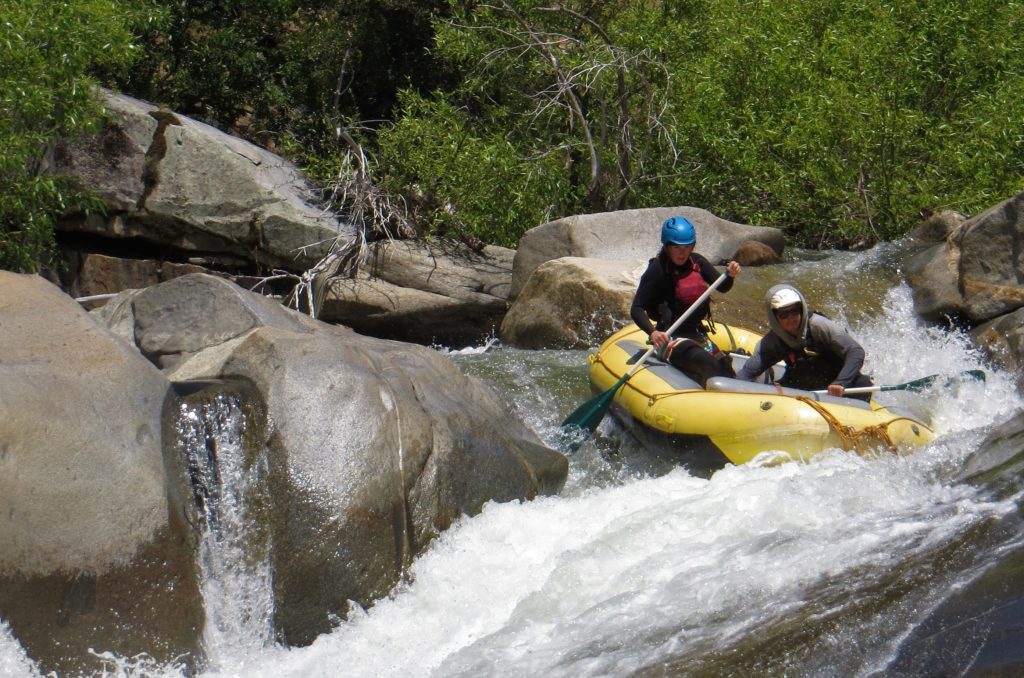
Sun Gloves
If you are paddling or just hanging out on a raft it is nice to have something to protect your hands from the sun. A light weight pair of 50+ UPF gloves will do the trick. The palms on the gloves get beat up pretty quick but the backs of your hands will still be well protected.

Knee & Thigh Sun Protection
The knees and lower thighs are common places to see turn red after a day of rafting. The two best options are wearing longer capris style shorts (they do have men’s capri options) or sun tights (there are men’s surf tights as well). Capris style shorts stay wet longer than regular shorts but are less annoying than wearing full length pants on the river. Sun tights dry quickly and seem to be growing in popularity. Some people wear shorts over their tights while others do not. The “man-pris” may not seem that cool but they are ideal for multi-day rafting trips in the middle of the summer.
Zippered Pocket
When rafting a zippered pocket is nice for storing chapstick or any other small need that you don’t want to loose. Ideal the pocket is on a pair of shorts or a shirt. Just be sure the pockets doesn’t interfere with your ability to sit, wear your PFD or paddle. Even if you have a zippered pocket, don’t bring your keys on the river if possible.
What to Wear Cold Weather River Rafting
Rafting on a cold or splashy day can still be fun as long as you have the right gear. First we’ll look at splashy rafting days and then discuss what to wear while rafting on those colder spring (April, May) and fall (September, October) trips. Note that some outfitters provide wetsuits and splash jackets on colder trips so check your packing list to see what you are responsible for. Be sure to bring an extra set of clothes to change into after the trip.
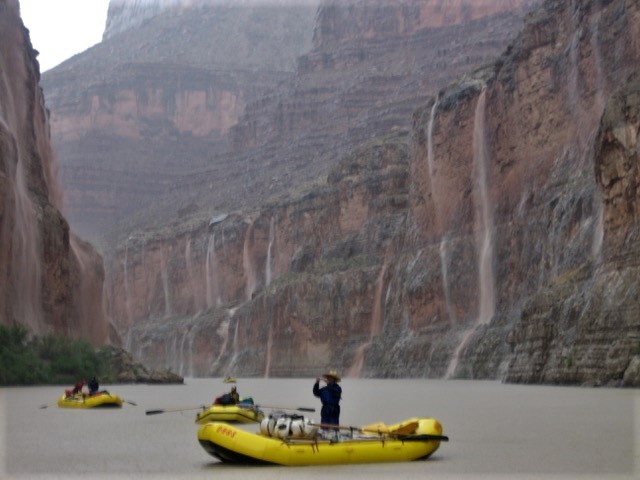
Waterproof Outer Layer
For splashy trips with cold water it is nice to have a waterproof splash jacket with gusseted wrists and neck to keep the water out. A waterproof womens or mens rainjacket with sealed seams will also work pretty well and is usable in more situations after your trip. Waterproof mens or womens rain pants also keep rafters much warmer. Rain pants, if big enough, can also be worn over wetsuits dramatically improving comfort. If you raft often you’d probably be better off with some splash pants. For most summer time trips a rain jacket and a thin synthetic top will be more than enough for cool day of rafting.
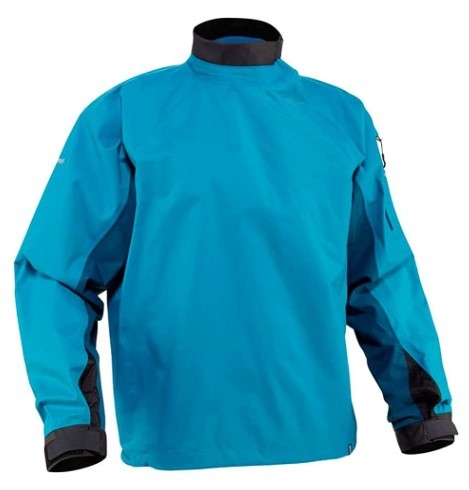
Thermal Layers
Under your rain suit or paddle suit you’ll want some long underwear insulation. Luckily, most sun hoodies are made with polyester and make good thin layering. Avoid cotton since it is better at cooling than keeping you warm. Pricier wool long underwear works similarly to polyester without being so stinky. On colder days it is nice to have a thicker fleece layer (womens or mens) to wear over a sunhoodie or long-underwear top. On the bottoms having some thin synthetic long-underwear (which can double as UPF tights under shorts) and a set of thicker fleece pants will keep most people comfortable. However, if you are wearing a wetsuit you will not want to wear the fleece pants.
What to Wear Under a Rafting Wetsuit
Wetsuits on mainly used on colder trips in the spring and fall. If required most outfitters will provide farmer-john & jane style rafting wetsuits which cover your legs and torso but not your arms. Many times outfitters also provide a splash jacket but you will still need something to wear under the jacket. Using a thin synthetic top under the wetsuit helps prevent irritation from the shoulder straps of the wetsuit. Avoid wearing shorts over your wetsuit, it adds significant drag when swimming rapids.
“Do I need a Wetsuit?”
A common question is “Do I need to wear a wetsuit?” Yes, on many rivers you are required to wear a wetsuit. Wetsuits help protect you from getting hypothermia if the weather and water are cold. They also provide additional padding for swims in rapids on rocky, treacherous rafting trips. I wear a wetsuit on Class V runs for this reason. Note that farmer john/jane wetsuits can be 2 or 3 mm thick. The 3 mm seems to be the better all around option for warmth and padding. Outfitters typically provide wetsuits if they are required.
Surfing Wetsuits on River Trips
Surfing wetsuits also work well for rafting. In general I find 4/3 mm long sleeve wetsuit to be ideal for most colder trips. It is still nice to be able to wear a rain jacket over the top on cooler windy days. Also, some people have problems with rashes in the arm pits using older wetsuits so make sure you have a rash guard. Surfing booties however tend to have soles that are too thin to work well on rafting trips.
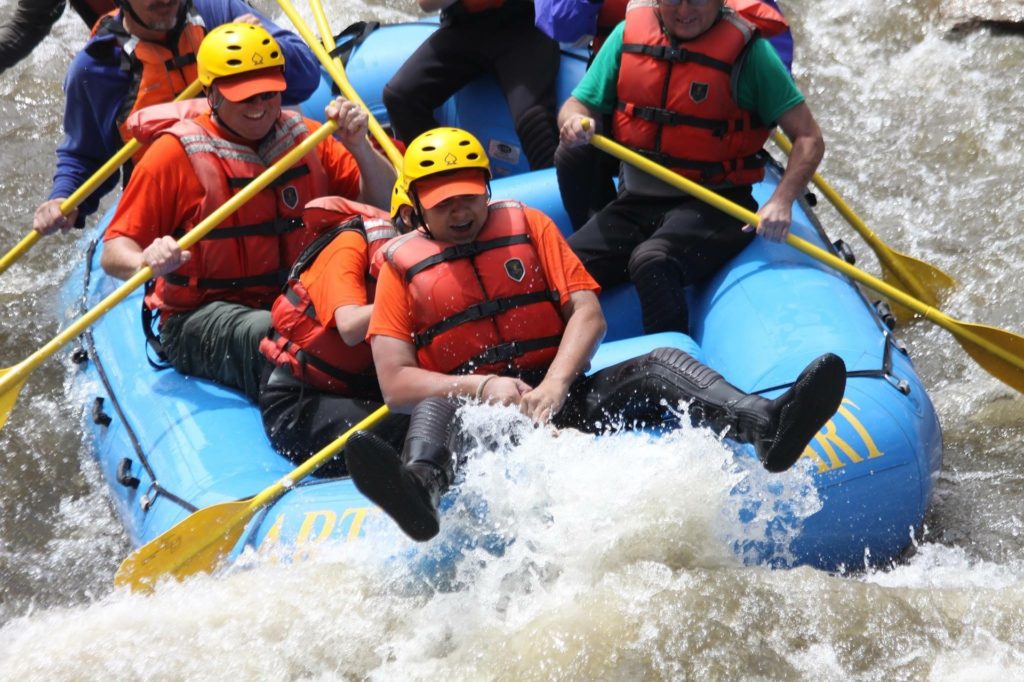
Staying as Warm as Possible in a Wetsuit
On the coldest days a thick fleece layer under the splash top and a wool or synthetic cap helps maintain core temperature. Wearing paddling pants or rain pants over the wetsuit significant reduces evaporative cooling and splash cooing from rapids. Finally river shoes with neoprene socks keep feet way warmer, be sure to tuck the tops of the socks inside your wetsuit bottoms.
I’ve known people that only had wool socks so they wore plastic bags over their socks inside their shoes and tucked into the legs of their wetsuit. This vapor barrier keep their feet much warmer. A pair of cheap dish washing gloves also are nice for keeping hands warmer without loosing too much dexterity. You can even wear thin knit gloves under the gloves.
What Not to Wear Whitewater Rafting
Below is a list of items that do not meet most rafting dress codes even for a float trip.
- flip flops, crocs, cowboy boots, high heals, bare feet, heavy boots & shoes
- cotton on cold days
- jewelry, keys, cellphones, wallets, anything that can’t get wet or you’d be super bummed if you lost it. Fingers shrink in cold water and rings have been lost.
- jeans, leather, cotton sweatshirts
- tight and restrictive clothing making it hard to swim or paddle
- scarfs or anything similar that could get caught on equipment creating an entrapment hazard
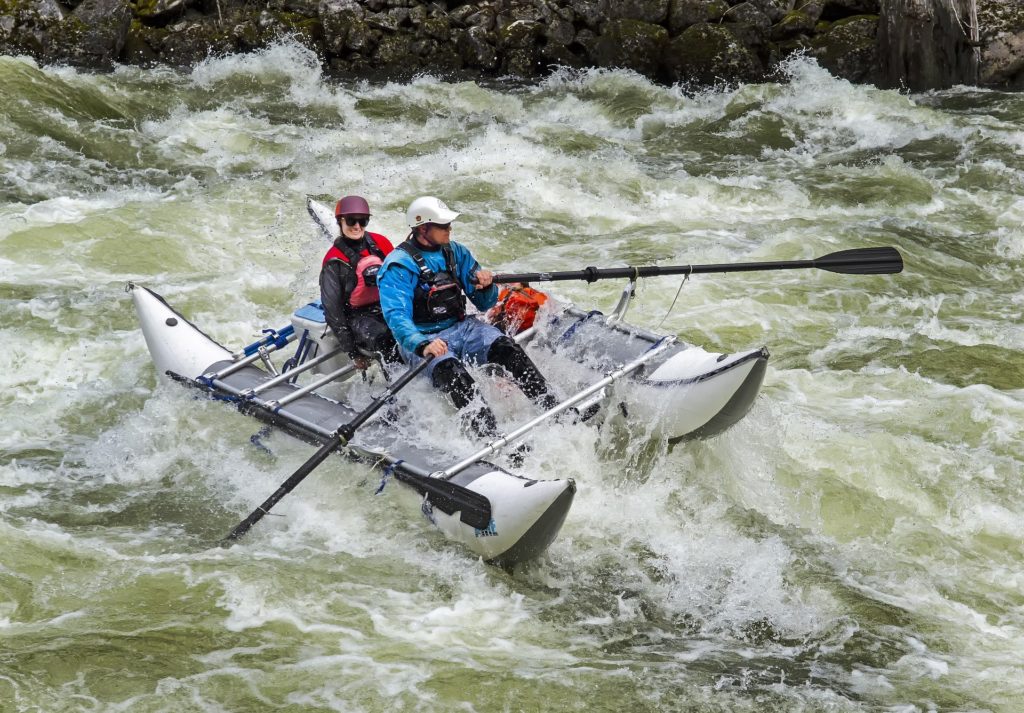
Drysuits
Drysuits work wonderfully on cold weather trips or if you will be spending a bunch of time in the river. They have latex gaskets at the wrists and neck. For the feet there are either latex seals or even better Gore-Tex water proof socks. Drysuits make it easy to layer with fleece and poly-propylene long underwear according to how cold the day will be.
Many people don’t like how tight drysuit gaskets are around their necks. Also, the gaskets break fairly easily and degrade quickly over time particularly when exposed to sun. A broken gasket mean instead of being dry and warm while rafting, water can get inside the suit soaking what should be dry undergarments. It’s important to do proper care and maintenance of a drysuit. The other problem with drysuits is they restrict mobility much more so than a wetsuit does.
Drysuits are expensive to buy and require ongoing maintenance. However, there are companies that rent drysuits like Immersion Research and Pacific River Supply. They ship the drysuit to you and after your trip you ship it back to the company in the same box.
Video: What to Wear Rafting under a Drysuit
Final Thoughts on Clothing for Rafting Trips
When packing your white water rafting attire plan for sun or rain. Even in the middle of the summer in the desert you can encounter a rain storm. Dress to swim, make sure your river clothes aren’t too baggy or restrictive in case you take a dunk. Ideally your shoes are light weight but secure to your feet.
If you know the trip could be really cold and wet (like the Illinois River) or an early season guide school consider a drysuit. While many outfitters provide a small drybag to use for personal stuff, depending upon the trip you may also want to bring a drybag to keep certain items dry. Finally remember the clothing you will need depends upon the trip so check-in with your outfitter or someone who has been on the river before.
